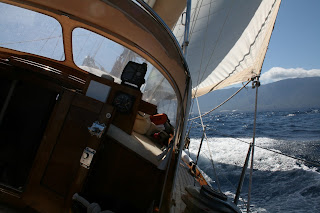We took a bus to Fuencaliente in the South of the island, the area of volcanic activity. You can imagine Tristan's pleas ....'no more volcano's'.
The walk was from the volcano San Antonio visitors centre down to Faro de Fuencaliente and the salt pans a distance of around 7km's but my calves disagree.
We decided not to pay to see a volcanic crater which last erupted in 1677, but opted to walk downhill to the coast. In the middle of nowhere you came across grape vines growing in the cinders.
This area of La Palma is famous for its wines grown on the island since 1505, which accounted for the number of bodega's we passed en route.
Malmsey wine was praised by Shakespeare and his contemporaries. I have yet to try it!
Vineyards on the slopes around Volcano San Antonio with the marina in the very far distance.
Random vineyard in front of Volcano Teneguia
It was blazing hot and with all the black cinders the temperatures soared. We resorted to drinking out of the water canals using Tristan's hat.....may regret this later!
The San Antonio cinder cone.

You knew you would be in trouble if you slipped. The view at
the top was spectacular (if you like volcanoes he muttered!).
I should have realised from walking down Etna, that sandals were a bad idea, but the volcanic material on El Hierro was completely different and much easier to walk on so I had long abandoned my boots. At least it gave me an excuse to stop (every five minutes) and empty my sandals! The lava was quite different from El Hierro, mainly sharp cinders (scoria) ranging in colour from reds to blacks and bluish tinges where the material had come into contact with water when it erupted.


The salt pans were adjacent to the two lighthouses. Faro Negra was damaged during the volcanic eruption of 1971 and they built a new red and white striped one adjacent. There is absolutely nothing here but the lighthouses and the salt pans.
They were rebuilding the visitors centre so we walked around the salt pans following the information boards.
By this time we were desperate for water ....and filled up the bottles from a tap. The green floaty bits were a bit off putting but was no where else to get water.
The process of salt recovery was interesting......
Water is pumped to inlet pools which trickle the water down into the saltpans. The colour is due to an algae Dunaliella salina and aparently there are also brine shrimps, Artemia which I remember my girls having as pets when the were young. Sea monkeys! These should have been a trade description issue!

Fortunately a gua gua returned us to Fuencaliente but via the most extensive plantations of bananas yet. Considering the number of bananas on this island, I reckon they must supply most of Europe.
You used to be able to buy banana puree to drink on the islands but it seems to have disappeared. However there is an increase in the number of cosmetics using bananas which I'm sure is much more profitable!


























































